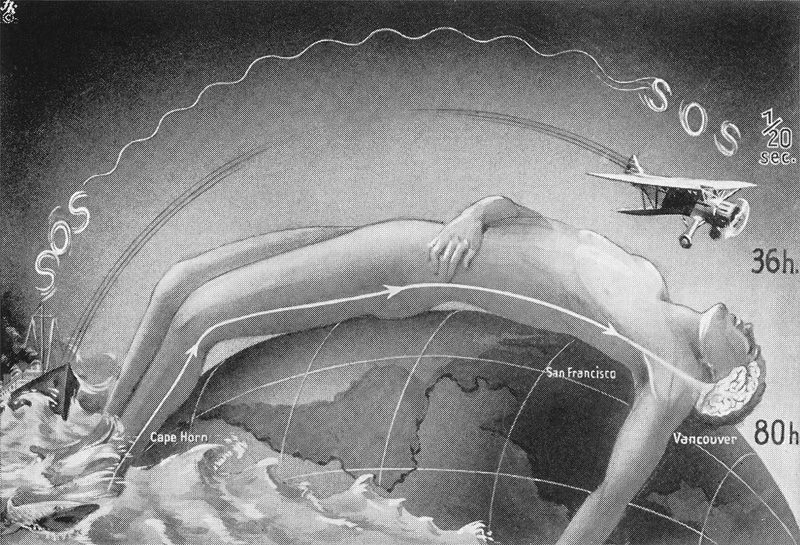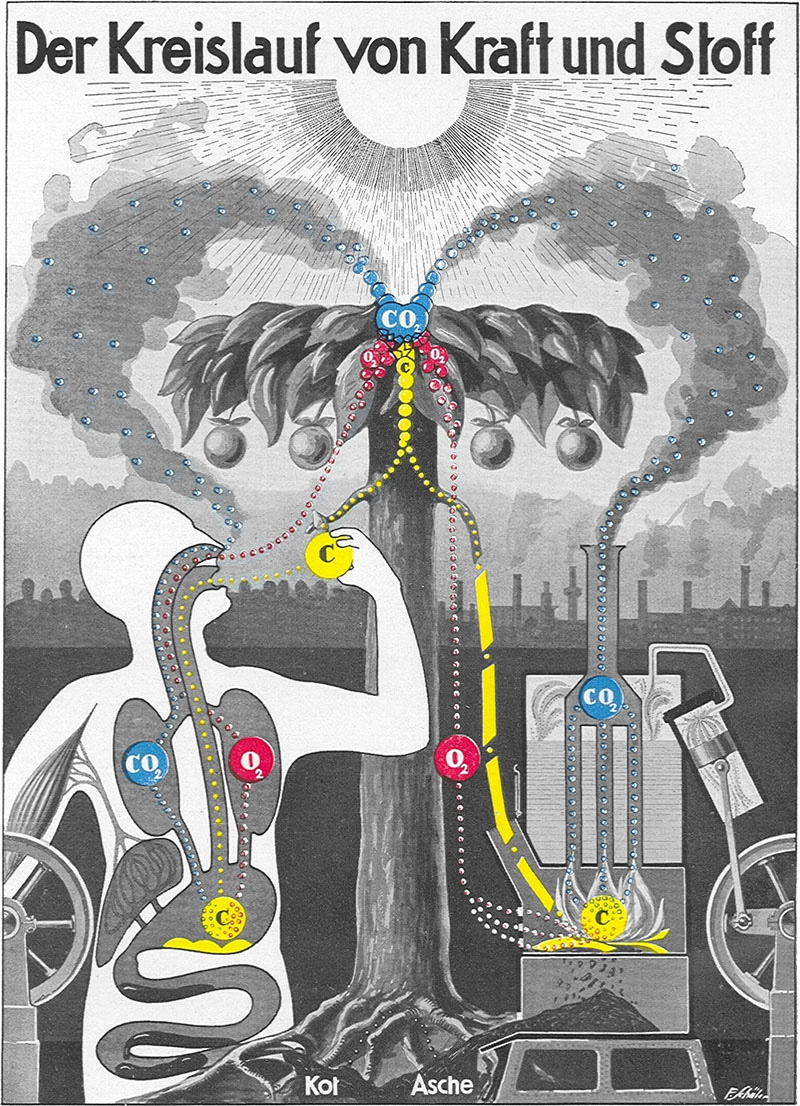Fritz Kahn: The Little-Known Godfather of Infographics
by Maria Popova
How a German gynecologist transformed science into visual poetry and laid the foundations of modern information graphics.
 Around the time when Austrian sociologist, philosopher, and curator Otto Neurath was building his ISOTYPE visual language,
which laid the foundation for pictogram-based infographics, another
infographic pioneer was doing something even more ambitious: The German
polymath Fritz Kahn — amateur astronomer, medical
scientist by training, gynecologist by early occupation, artist by
inclination, writer, educator and humanist by calling — was developing
innovative visual metaphors for understanding science and the human
body, seeking to strip scientific ideas of their alienating complexity
and engage a popular audience with those essential tenets of how life
works. Best-known today for his iconic 1926 poster Man as Industrial Palace, Kahn inspired generations of scientific illustrators, including such legends as Irving Geis and such cultural treasures as the 1959 gem The Human Body: What It Is And How It Works. His influence reverberates through much of our present visual communication and today’s best infographics .
Around the time when Austrian sociologist, philosopher, and curator Otto Neurath was building his ISOTYPE visual language,
which laid the foundation for pictogram-based infographics, another
infographic pioneer was doing something even more ambitious: The German
polymath Fritz Kahn — amateur astronomer, medical
scientist by training, gynecologist by early occupation, artist by
inclination, writer, educator and humanist by calling — was developing
innovative visual metaphors for understanding science and the human
body, seeking to strip scientific ideas of their alienating complexity
and engage a popular audience with those essential tenets of how life
works. Best-known today for his iconic 1926 poster Man as Industrial Palace, Kahn inspired generations of scientific illustrators, including such legends as Irving Geis and such cultural treasures as the 1959 gem The Human Body: What It Is And How It Works. His influence reverberates through much of our present visual communication and today’s best infographics . Now, visual culture powerhouse Taschen has captured the life’s work of this infographic pioneer in the magnificent monograph Fritz Kahn (public library) — a 6-pound tome in English, French and German that collects and contextualizes his most influential images and essays and, above all, celebrates a boundless mind that never settled for limiting itself to a single discipline, to any one area of curiosity, to the onus and hubris of specialization that our culture so vehemently and so toxically fetishizes.
In the introduction, the prolific design historian and writer Steven Heller calls Kahn and Neurath “two sides of the same pie chart,” despite the fact that they likely never met:
Each passionately sought to devise a distinct graphic design language to replace the jargon and lay waste to an ever-growing Tower of Babel.Like Neurath, who didn’t actually create the symbols he became known for, Kahn was not an artist himself but compensated for it with the potent combination of his powers of logic and his ability to surround himself with top talent, who would execute his visions while also expanding his taste and visual literacy. Though his innovative methods were themselves a force to be reckoned with, the underlying impetus was as simple as it was profound: Kahn was just a brilliant science communicator who sought to engage the public’s imagination in popularizing science. He used his infographics as Carl Sagan did narrative and the moving image, subverting the medium — and subverting it masterfully — to the goals of the message. Heller writes:
His graphic design preferences were eclectic and included such methods as photo-collage, painting and drawing and styles like comic, surrealist, dada and more. The art of analogy was Kahn’s forte (sometimes to the extreme): he might compare an ear with a car or a bird’s feather with railroad tracks, all meant to explain ever more impenetrable phenomena by means which triggered the viewer’s imagination. Kahn employed whatever visual trick he could cobble together for the end result: popular comprehension.But how did Kahn come to shape culture so profoundly? Editors Uta von Debschitz and Thilo von Debschitz write in the introduction:
[…]
The legacy of Kahn’s work has resonance now and will continue into the future.
In the first decades of the 20th century, Berlin was the center for a huge variety of political, social and cultural energies, which in their explosive interaction unleashed among other things a firework display of new aesthetic forms. Fritz Kahn combined some of these innovative texts and pictorial forms into a popular scientific “overall painting of man in the light of modern science.” The work, entitled The Life of Man (1922–31), contains so many highly expressive verbal and pictorial metaphors that one reviewer said Kahn was inclined “to illustrate every statement within a picture that knocks a hole in the skull of even the most slow-witted reader” — an opening for new insights and options.It’s rather telling that even that reviewer used such a visceral bodily metaphor to convey a conceptual idea — it was precisely in enlisting the physical to explain the metaphorical that Kahn found his greatest power. As a scientist, he understood the visual bias of our brains; as an artistically minded design-thinker, he knew how powerfully graphics could convey ideas and ideologies; as a man of medicine, he grasped the importance of visualizing the body to illuminate its inner workings.

But Kahn was far from reducing a human being to mere machinery. The von Debschnitz write:
His factories, engine-rooms and laboratories do not work on their own, but are operated and driven by large numbers of workers. These human figures make visible certain activities of individual cells or organs, but they also stand for life itself, which keeps the “man machine” running. In Kahn’s pictorial world there is plenty of room alongside the demonstrable for the unconscious, the unfamiliar and the intangible. He sees metaphysics and science not as opposites but as two sides of the same coin, as the “heaven and earth of the human soul.”

Kahn’s conceptual illustrations inverted the text-image relationship that had prevailed until then. The picture took prominence and switched from observed object to active agent, opening up new imaginary spaces for the viewer. It challenged the viewer to explore these spaces independently, to find [his or her] place in them, and develop new perspectives from there — a life-saving ability in a crisis-torn age like that of [the world war].In a twist of tragic irony, Kahn himself followed the fate of many Jewish intellectuals and was forced to flee Germany when the Nazis took power. His books were confiscated, banned and burned, and put on a list of “damaging and undesirable writing.” His images, however, remained in use thanks to blatant plagiarism — worst of all, the science journal editor and self-professed Nazi Gerhard Venzmer ripped off Kahn’s “man book” in a similar edition that featured an extra chapter on “racial studies and racial care,” full of the expected bigoted atrocities. Fortunately, Kahn was able to sue for copyright after the end of WWII and won the case — but the experience demonstrated both the power of his images and the challenging cultural context in which he created them.
[…]
Apart from instruction and entertainment, edification is another important function of the illustrated factual book. Meaning, comfort, fresh perspectives, and ideally a faith that can move mountains, often form in reaction to a strong aesthetic impulse — for example, in the borderland between science and art. Kahn knew the healing effect of the “imagination” from personal and medical experience, especially in relation to observing the macro- or microcosm. … Verbal and visual images can help man (re)connect with himself, his group, the world and the universe, to find his way or place.
Above all, however, Kahn was a kind of scientific poet who enlisted the tenets of literature and the arts in making scientific ideas not only accessible but exciting. One of the most beautiful examples of this comes from his 1924 article for the journal Kosmos, titled “Fairy-tale Journey on the Bloodstream.” In it, he extols “the drama which, since its discovery 200 years ago, has repeatedly stirred the ecstasy of all who have seen it: the circulation of the blood” and writes — sings, almost:
“What a drama, but alas, only a drama!” The microscope’s field of vision is narrowly limited and we see the blood cells arriving on one side and disappearing again on the other… where from? where to? — we don’t know […]. The researcher stops at the rigid circle of his microscope’s field of vision, but we, we are poets, and who will forbid the imagination to travel to magical realms over lands and over seas like the child with the seven swans? […] Like the hero of the “last fairy-tale” we become smaller and smaller until at last we stand microscopically tiny, mini-Lilliputians on the bank of the vein-stream, and see the cells drifting past us, as big as the barques [large sailing ships] of men. We climb up one of the cliffs that loom into the stream, and wait. Cell after cell swims past, but quick and in the middle of the stream, unattainable to our desires. At last, however, a cell-boat drifts close to us on the beach, settles askew like a ship run aground, we leap across and into it, now it tilts from side to side, we push off and sail away. We are sailing! In our cell-boat on the red-gold stream of blood! Farewell, realm of man! We are in the land of fairy-tales, the fairy-tale land of truth, above which you rough giants gap blithely away on your great feet, and we sail towards miracles, true miracles!Fritz Kahn is itself a miracle of human imagination, wholeheartedly recommended.






Nessun commento:
Posta un commento
Salve, donatemi un pò dei Vostri Pensieri: